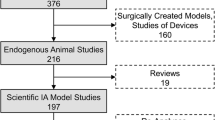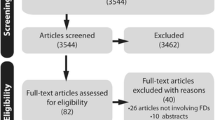Abstract
Experimental models of intracranial saccular ancurysms are a useful contribution to our basic understanding of these lesions. Currently, the commonest in use are those constructed surgically in laboratory animals. We review the numerous surgical techniques available since the 1950s, and the research applications and uses of experimental aneurysms. Further development and use of such models is greatly encouraged in future pathophysiological, hemodynamic, and therapeutic investigations of intracranial saccular aneurysms.
Similar content being viewed by others
References
Jellinger K (1977) Pathology of intracerebral haemorrhage. Zentralbl Neurochir 38:29–42
Ljunggren B, Brandt L, Saveland H, et al (1987) Management of ruptured intracranial aneurysm: a review. Br J Neurosurg 1:9–32
Forrest MD, O'Reilly GV (1989) Production of experimental aneurysms at a surgically created arterial bifurcation. AJNR 10:400–402
Hunter J (1839) In: Palmer JF (ed) Lectures on the principles of surgery. Haswell, Barrington & Haswell, Philadelphia, p. 309
Halsted WS (1924) In: Burket WC (ed) Surgical papers, 1. Johns Hopkins Press, Baltimore, pp 469–475
Shumacker HB, Lowenberg RI (1948) Experimental studies in vascular repair. I. Comparison of reliability of various methods of end-to-end arterial sutures. Surgery 24:79–89
McCune WS, Samadi A, Blades B (1953) Experimental aneurysms. Ann Surg 138:216–218
German WJ, Black SPW (1954) Experimental production of carotid aneurysms. New Eng J Med 250:104–106
Cooper AJ, Johnson CD (1991) Animal experimentation. Br J Surg 78:1409–1411
Hashimoto N, Kim C, Kikuchi H, et al, (1987) Experimental induction of cerebral aneurysms in monkeys. J Neurosurg 67:903–905
Ask-Upmark E, Ingvar D (1950) A follow-up examination of 138 cases of subarachnoid hemorrhage. Acta Med Scand 138: 15–31
du Boulay GH (1965) Some observation on the natural history of intracranial aneurysms. Br J Radiol 38: 721–727
Andrews EJ, White WJ, Bullock LP (1975) Spontaneous aortic aneurysms in blotchy mice. Am J Pathol 78: 199–207
Stehbens WE (1975) Flow in glass models of arterial bifurcations and berry aneurysms at low Reynolds numbers. Quart J Exp Physiol 60: 181–192
Hashimoto T (1984) Dynamic measurement of pressure and flow velocities in glass and silastic model berry aneurysms. Neurol Res 6: 22–28
Kerber CW, Heilman CB (1983) Flow in experimental berry aneurysms: method and model. AJNR 4: 374–377
Brown N (1991) A mathematical model for the formation of cerebral aneurysms. Stroke 22: 619–625
Perktold K (1987) On the paths of fluid particles in an axisymmetrical aneurysm. Biomechanics 20: 311–317
Wong PKC, Johnston KW, Ethier CR, et al. (1991) Computer simulation of blood flow patterns in arteries of various geometries. J Vasc Surg 14: 658–667
Cheong J (1989) The use of animals in medical education: a question of necessity vs. desirability. Theor Med 10: 53–57
TerBrugge KG, Lasjaunias P, Hallacq P (1991) Experimental models in interventional neuroradiology. AJNR 12: 1029–1033
Heilman CB, Kwan ESK, Wu JK (1992) Aneurysm recurrence following endovascular balloon occlusion. J Neurosurg 77: 260–264
Young PH, Yasargil MG (1982) Experimental carotid artery aneurysms in rats: a new model for microsurgical practice. J Microsurg 3: 135–146
Nishikawa M, Smith RD, Yonekawa Y (1977) Experimental intracranial aneurysms. Surg Neurol 7: 241–244
Yonekawa Y, Yasargil MG, Handa H (1973) Practice of microvascular anastomosis. Neurol Surg 1: 345–351
Osterman FA, Bell WR, Montali RJ, et al (1976) Natural history of autologous blood clot embolization in swine. Invest Radiol 11: 267–276
Bookstein JJ, Chlosta EM, Foley D, et al (1974) Transcatheter hemostasis of gastrointestinal bleeding using modified autogenous clot. Radiology 113: 277–285
Guglielmi G, Viñuela F, Sepetka I, et al (1991) Electrothrombosis of saccular aneurysms via endovascular approach. Part I: Electrochemical basis, technique, and experimental results. J Neurosurg 75: 1–7
Guglielmi G, Ji C, Massoud TF, et al (1994) Experimental saccular aneurysms. II. A new model in swine. Neuroradiology 36: 547–550
Orlin JR, Osen KK, Hovig T (1991) Subdural compartment in pig: a morphologic study with blood and horserdish peroxidase infused subdurally. Anat Rec 230: 22–37
Rand RW (1991) Thrombogenic microballon for cerebral ancurysms, arteriovenous malformations, and carotid cavernous fistula occlusion. Surg Neurol 35: 403–407
Kerber CW, Buschman RW (1977) Experimental carotid aneurysms: I. Simple surgical production and radiographic evaluation. Invest Radiol 12: 154–157
White JC, Sayer GP, Whisnant JP (1961) Experimental destruction of the media for the production on intracranial arterial aneurysms. J Neurosurg 18: 741–745
Tolstedt GE, Bell JW (1963) Production of experimental aneurysms in the canine aorta. Angiology 14: 459–464
Quigley MR, Tuite GF, Cozzens JW (1988) Histology and angiography in a bifurcation aneurysm model. Surg Neurol 30: 445–451
Sadasivan B, Ma S, Dujovny M, et al (1990) Use of experimental aneurysms to evaluate wrapping materials. Surg Neurol 34: 3–7
Molinari GF, Smith L, Goldstein MN, et al (1973) Pathogenesis of cerebral bacterial aneurysms. Neurology 23: 325–332
Graves VB, Partington CR, Rufenacht DA, et al (1990) Treatment of carotid artery aneurysms with platinum coils: an experimental study in dogs. AJNR 11: 249–252
Strother CM, Graves VB, Rappe A (1992) Aneurysm hemodynamics: an experimental study: AJNR 13: 1089–1095
Terai Y, Sugiu K, Mandai S (1992) Unbranched-site aneurysm of internal carotid artery. Neurol Surg 20: 741–748
Black SPW, German WJ (1960) Observations on the relationship between the volume and the size of the orifice of experimental aneurysms. J Neurosurg 17: 984–990
Graves VB, Strother CM, Partington CR, et al (1992) Flow dynamics of lateral carotid artery aneurysms and their effects on coils and balloons: an experimental study in dogs. AJNR 13: 189–196
Guity A, Young PH, Fischer VW, et al (1991) Mural repair following obliteration of aneurysms. Part III: Pathomorphological effects of Nd: YAG laser on aneurysm obliteration. Microsurgery 12: 30–34
Mandai S, Kinugasa K, Ohmoto T (1992) Direct thrombosis of aneurysms with cellulose acetate polymer. Part I: Results of thrombosis in experimental aneurysms. J Neurosurg 77: 497–500
Miyachi S, Negoro M, Handa T, et al (1992) Vascular endoscopy for intravascular surgery — an experimental study. Neurol Med Chir 32: 323–327
Moringlane JR, Grote R, Vonnahme FJ, et al (1968) Occlusion of experimental artery aneurysms by intrasaccular injection of fibrin sealant. Acta Neurochir (suppl) 43: 193–197
O'Reilly GV, Utsunomiya R, Rumbaugh CL, et al (1981) Experimental arterial aneurysms: modification of the production technique. J Microsurg 2: 219–223
Sandor T, Utsonomyia R, Rumbaugh C, et al (1980) On the feasibility of densitometric assessment of cerebral aneurysms. Int J Biomed Comput 11: 487–500
Zanetti PH, Sherman FE (1972) Experimental evaluation of a tissue adhesive as an agent for the treatment of aneurysms and arteriovenous anomalies. J Neurosurg 36: 72–79
Young PH, Fischer VW, Guity A, et al (1972) Mural repair following obliteration of aneurysms: production of experimental aneurysms. Microsurgery 8: 128–137
Nishikawa M, Yonekawa Y, Matsuda I (1976) Experimental aneurysms. Surg Neurol 5: 15–18
Maira G, Mohr G, Panisset A, et al (1979) Laser photocoagulation for treatment of experimental aneurysms. J Microsurg 1: 137–147
Debrun GM, Varos V, Liszczak TM, et al (1984) Obliteration of experimental aneurysms in dogs with isobutyl-cyanoacrylate. J Neurosurg 61: 37–43
Miyachi S, Negoro M, Handa T, et al (1992) Histopathological study of balloon embolization: silicone versus latex. Neurosurgery 30: 483–489
Yapor W, Jafar J, Crowell RM (1991) One-stage construction of giant experimental aneurysms in dogs. Surg Neurol 36: 426–430
Stehbens WE (1973) Experimental production of aneurysms by microvascular surgery in rabbits. Vasc Surg 7: 165–175
Black SPW (1963) Experimental saccular aneurysm by an arterio-venous fistula method. Mo Med 60: 340–343
Mawad ME, Mawad JK, Goodman JC, et al (1992) Long-term endothelial changes in canine aneurysms embolized with GDC coils. Proc 30th Annual Meeting American Society of Neuroradiology, p 86
Suga T, Sugawara T, Yoshimoto T, et al (1992) Experimental study of aneurysmal occlusion with fibrin glue. Neurol Surg 20: 865–873
Fallon JT, Stehbens WE (1973) The endothelium of experimental saccular aneurysms of the abdominal aorta in rabbits. Br J Exp Pathol 54: 13–19
Fingerhut AG, Alksne JF (1966) Thrombosis of intracranial aneurysms. An experimental approach utilizing magnetically controlled iron particles. Radiology 86: 342–343
Ives FJ, ApSimon HT, Storrie A (1991) A simple animal model of arteriovenous fistula and aneurysm: in vivo studies of detachable balloon techniques. Neuroradiology 33 (Suppl): 537–538
Robert G, Hardy J (1973) Etude expérimentale de l'éxclusion des anévrysmes saccularies. Neuro-Chirurgerie 19: 373–386
Troupp H, Rinne T (1964) Methyl-2-cyanoacrylate (Eastman 910) in experimental vascular surgery. J Neurosurg 21: 1067–1069
Ferguson GG (1970) Turbulence in human intracranial saccular aneurysms. J Neurosurg 33: 485–497
van Alphen HAM, Young-Zhong G, Kamphorst W (1990) An acute experimental model of saccular aneurysms in the rat. Neurol Res 12: 256–259
Yong-Zhong G, van Alphen HAM, Kamphorst W (1990) Observations on experimental saccular aneurysms in the rat after 2 and 3 months. Neurol Res 12: 260–263
Roach MR (1974) Blood flow and thrombosis (particularly in aneurysms). Thromb et Diath Hem (Suppl) 59: 123–138
Roach MR (1978) A model study of why some intracranial aneurysms thrombose but others rupture. Stroke 9: 583–587
Sekhar LN, Sclabassi RJ, Sun M, et al (1988) Intra-aneurysmal pressure measurments in experimental saccular aneurysms in dogs. Stroke 19: 352–356
Geremia GK, Hoile RD, Haklin MF, et al (1990) Balloon embolization of experimentally created ancurysms: an animal training model. AJNR 11: 659–662
Kamphorst W, Yong-Zhong G, van Alphen HAM (1991) Pathological changes in experimental saccular aneurysms in the carotid artery of the rat. Neurol Res 13: 55–59
Yong-Zhong G, van Alphen HAM, Kamphorst W (1991) Effect of contralateral carotid ligation on experimental carotid artery aneurysm in the rat. Neurol Res 13: 60–64
Patil AA, Yamanashi W, Valentine J, et al (1986) Electromagnetic field focusing (EEF) probe in aneurysm thrombosis. Preliminary report. Acta Neurochir 81: 68–71
Yamanashi WS, Patil AA, Valentine JL, et al (1987) Electromagnetically induced focused heat in the treatment of surgically created aneurysm models. Invest Radiol 22: 574–580
Young PH, Fischer VW, Young PA, et al (1988) Mural repair following obliteration of aneurysms: II. Pathomorphology of treated aneurysms. Microsurgery 9: 194–203
Debrun G, Lacour P, Caron JP, et al (1975) Inflatable and released balloon technique experimentation in dog — application in man. Neuroradiology 9: 267–271
Whalen E (1992) The Society of Cardiovascular and Interventional Radiology: 17th annual scientific meeting. April 1992. AJR 159: 639–645
Kwan ESK, Heilman CB, Shucart WA, et al (1991) Enlargement of basilar artery aneurysms following occlusion — “waterhammer effect”. Report of two cases. J Neurosurg 75: 963–968
Genest AS (1965) Experimental use of intraluminal plastics in the treatment of carotid aneurysms. J Neurosurg 22: 136–140
O'Reilly GV, Forrest MD, Schoene WC, et al (1989) Laser-induced thermal occlusion of berry aneurysms: initial experimental results. Radiology 171: 471–474
Powell J (1991) Models of arterial aneurysm: for the investigation of pathogenesis and pharmacotherapy — a review. Atherosclerosis 87: 93–102
Ostergaard JR, Oxlund H (1987) Collagen type III deficiency in patients with rupture of intracranial sacular aneurysms. J Neurosurg 67: 690–696
English DC (1989) Using animals for the training of physicians and surgeons. Theor Med 10: 43–52
Murray JD (1989) Mathematical Biology. Springer, Berlin Heidelberg New York, p 25
Author information
Authors and Affiliations
Rights and permissions
About this article
Cite this article
Massoud, T.F., Guglielmi, G., Ji, C. et al. Experimental saccular aneurysms. Neuroradiology 36, 537–546 (1994). https://doi.org/10.1007/BF00593517
Received:
Accepted:
Issue Date:
DOI: https://doi.org/10.1007/BF00593517




